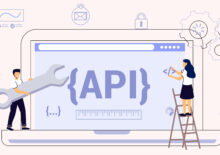APIs have become essential elements in today’s software ecosystem. Whether you’re an experienced developer or a business that benefits from their usefulness, understanding the role of APIs is increasingly important. Let’s take a look at what they actually are and why they are so important.
What are Web APIs?
Web APIs (because in what follows we will only refer to these, not local APIs), or Web Application Programming Interfaces, are vital elements in the modern digital universe. They act as a link between applications on the internet, facilitating communication and data exchange between different online services and platforms. Unlike local APIs, which operate within the same device or system, Web APIs enable remote interactions over the internet that were hard to imagine decades ago.
Thanks to Web APIs (which we’ll hereafter simply call APIs), your favourite apps can provide real-time weather information, suggest music you might enjoy, or allow you to share content directly on social networks, all through simple HTTP calls. These APIs are driving innovation and efficiency in the digital space. In the business world, they are often the key enabler that allows companies to scale quickly, extend functionality without rebuilding the entire system from scratch, and collaborate effectively with external partners.
A clear example is the use of APIs in integrated payment systems. When you make a purchase in an online shop, an API facilitates the transaction between the website and the payment service provider. This level of integration and automation, made possible through API calls, radically transforms the way we interact and transact in the online space.
How do APIs work?
An API is a collection of rules and specifications that developers use to access and interact with functionality or data in a software or platform. Essentially, an API defines the methods and data you can request, as well as the format in which you will receive responses. Imagine the API as a waiter in a restaurant. The menu it provides is the API’s documentation, describing what requests you can make and what responses to expect. Just as the waiter sends your order to the kitchen and then brings you your food, the API takes your requests, processes them according to the application’s logic and returns the data or results you want.
Types of Web APIs
There are different types of Web APIs, each with its own uses and advantages. Let’s go through the most common and effective types of Web APIs used today.
1. REST APIs
REST (Representational State Transfer) is an architectural style that uses existing web standards, especially HTTP. REST APIs are designed around resources, with each resource accessible via a unique URL. Standard HTTP operations such as GET, POST, PUT and DELETE are used to read, create, update or delete resources. REST is valued for its simplicity and scalability and is the most common type of Web API.
2. SOAP APIs
SOAP (Simple Object Access Protocol) is a stricter and more secure protocol compared to REST, using XML instead of any other message format to ensure strict message conformance. SOAP can be used over HTTP, SMTP, TCP, and JMS, and includes advanced security and transactional functionality. Although considered more cumbersome than REST, SOAP remains popular in enterprise systems where security requirements are high.
3. GraphQL APIs
GraphQL is a relatively new technology developed by Facebook that allows clients to request exactly the data they need, without the limitations of a fixed endpoint as in REST. In GraphQL, a client can send a single query to retrieve multiple resources, which reduces the need to make multiple requests to retrieve related information.
4. RPC APIs
RPC (Remote Procedure Call) is a technique that allows executing a procedure (function) in another space (e.g. on another server). RPC can be implemented in various ways, including XML-RPC where requests and responses are encoded in XML, and JSON-RPC which uses a JSON-based format for lower overhead compared to XML.
5. Webhook APIs
Webhooks are a simple way to allow web applications to communicate with each other. They allow a server to notify an external client when a new event occurs, instead of the client repeatedly polling the server for changes. Webhooks are often used for integrations with third-party applications, such as payment gateways or notification systems.
6. Other types of APIs
Technology continues to advance, and new styles of APIs are being developed to improve performance and flexibility. One example is gRPC developed by Google, which uses the Protocol Buffers format for data serialisation and is optimised for low-latency communications, making it ideal for microservices.
Each type of Web API has its advantages and disadvantages, with the right choice depending on the specific requirements of the application, the complexity of the data handled, and the interaction needs between different systems. Understanding and selecting the right type of API can have a significant impact on the success and performance of a web application.
Requests and responses
Communicating with an API is done through requests and responses. Here’s how the process works:
1. Request: This is the message you send to get something from the API. A request usually includes:
- HTTP method: such as GET (to receive data), POST (to send new data), PUT (to update existing data) or DELETE (to delete data).
- Endpoint: The specific URL to which you send the request, which indicates the resource you want to access or modify.
- Parameters: any additional information required by the request, either in the URL or in the request body.
- Headers: additional information about the request, such as the type of content expected in the response.
2. Response: what you get back from the API, which may include:
- HTTP status code: a numeric value indicating the success or failure of the request (e.g. 200 for success, 404 for „not found”, 500 for server error).
- Data: the requested information or resource, often returned in JSON or XML format.
- Response headers: which may provide additional information about the response or server status.
So much for APIs so far, but watch our blog and part two of this article, where we’ll discuss securing data in API operation, as well as the main applications. Until then, if you have any questions on this topic or want to discuss your project, you can drop us a message using the contact page.





